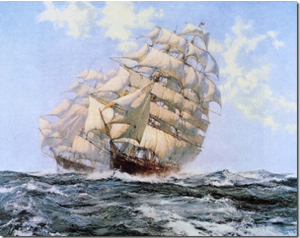Ships were used extensively in Europe, India, Asia and Africa to transport goods and people as well.
 They had completely new and original naval design characteristics, still emulated today by marine designers.
They had completely new and original naval design characteristics, still emulated today by marine designers.
To the foremast there may also be rigged one or more square topsails or, more commonly, one or more jib sails or Bermuda sails (triangular sails extending forward to the bowsprit or jibboom). Sources. Excavation of historic shipwreck remains from the Early Bronze Age, through the Greek and Roman period into Medieaval times confirms this. might carry eighty to a hundred men. Age of Sail. ... were often called upon to handle the clipper ships. The Clipper Ship Era/Chapter 8. Invented in 1800s in America, clipper ships rapidly became famous as cargo carrying vessels throughout the world. Built and used primarily in the mid-19th century. After Charles II used a yacht, they became vessels that were known to transport important persons. Today, the clippers are regarded as the apogee of ship design during the sailing era. Ships were traditionally made completely of timber. They were composed of tall masts and multiple sails, which enabled them to fare very quickly on open seas. Previously, yachts had been used by the Dutch navy. As John said, a small Roman ship and much bigger East Indiaman sailing the same speed represents significant technological progress because it is more difficult for a bigger ship to achieve the same speed as a smaller one. Excavation of historic shipwreck remains from the Early Bronze Age, through the Greek and Roman period into Medieaval times confirms this. The first is the calculation of the days run, from celestial observations. Taeping docked 28 minutes before Ariel - after a passage of more than 14,000 miles. Ship designs stayed fairly unchanged until the late 19th century. A clipper ship had three masts with square sails covering every coverable area on the mast. The first successful steam-powered vessels were built for use on canals and rivers in the early 1800s. It had three masts, was square-rigged, and the hull was designed to slice through … The introduction of the American clipper ships (the word “clipper” signified speed) with their narrow hulls and large sails enabled sea travel at speeds of up to 30 kilometers an hour, far faster than the average merchant ships. For a few brief decades between the end of the War of 1812 and the control of the world ’ s trade routes by the ocean steamers (after about 1860), America ’ s merchant marine enjoyed a golden era, in some areas challenging even the historical predominance of England on the high seas. Aged 14 years, Cutty Sark started recording remarkably fast passage times, under her Master Richard Woodget, and became the dominant ship in bringing wool from Australia to England. Schooner, a sailing ship rigged with fore-and-aft sails on its two or more masts. ... Why were railroads, clipper ships, and new inventions important to the north's economy? This was especially important early in that century in North America as the US and Canada were being settled and there was not yet an established system of roads or railways. Ships were traditionally made completely of timber. In many cases, clippers could travel much faster than steamboats; however, this was not entirely a good thing because in return for alacrity, the clipper ships of the 1800s sacrificed valuable cargo space. Even in the 1880s, sailing ships were still the main carriers of cargoes to and from Australia and New Zealand. Cutty Sark represents the pinnacle of clipper ship design and was one of the fastest ships of its day. ... Start studying American History Unit 8 Chapter 14 Essay Questions. might have a crew of five, while a clipper ships Clipper ship Fast, narrow-hulled sailing ship with tall masts, many sails, and large crews. There are two points that were not covered in the “Taffrail log” explanations below. The clipper ships of the 1850s are an inspiration for today's Coast Guard cutters, which are designed for speed in rough seas. So the designers of the great clipper ships of the 1840s and 1850s sharpened the bow and stern, creating much hollower lines than before. The Great Tea Race of 1866 was keenly followed in the press, with an extremely close finish. The most important aspect of a clipper ship was speed and it was built in such a way so as to enhance speed and help get more earnings to the owners of the cargo transported. 1800s: Clipper ships were built in the 1800s and were fast sailing ships, that featured tall masts, and slim, long hulls. Target sorry over 'Minnesota Badgers' onesies.
 They had completely new and original naval design characteristics, still emulated today by marine designers.
They had completely new and original naval design characteristics, still emulated today by marine designers. They had completely new and original naval design characteristics, still emulated today by marine designers.
They had completely new and original naval design characteristics, still emulated today by marine designers.